論説

Foreword
What are the key trends changing the insurance, pensions, and wealth management industries in Asia? And how can companies best capture growth?
These topics were among those discussed at the recent Singapore FinTech Festival (SFF). Since its inception in 2016, SFF has become the premier platform for the global fintech community to engage, connect, and collaborate on issues relating to the confluence of financial services, public policy, and technology. SFF attracted 62,000 participants from over 115 countries—the largest SFF gathering ever. It featured 850 speakers, 570 exhibitors, including 25 country pavilions, and over 4,000 meeting through the business matching platform.
Written in collaboration with
Written in collaboration with

With inflation persisting and growth slowing, many fintech firms are trying to remain viable. With that background, three key themes emerged at SFF that hold opportunities for insurance companies in Asia.
First, we discussed how risks for the current generation have changed, creating new paths of growth as technology spreads across all sectors and functions in the insurance industry. The changing behavior of consumers triggers new opportunities by demanding unconventional ways of redefining customer relationships.
Second, a widening pension gap caused by an aging population, the rise of self-employment, and the gig economy offers opportunities. We foresee that people caught in this gap could succumb to further risks raised by rising inflation, longer lifespans, and the rising cost of healthcare. Further, we discussed micro-pensions and micro-investments and how they would take off in the coming years.
Third, Asia’s financial wealth stands at $180.6 trillion as of 2021, or roughly 40% of global wealth, and we expect continued growth. This causes more customers to get serious about financial planning. We also discussed approaches to reaching Generation Y and Z customers who require an omnichannel experience to maintain high engagement.
We also had pragmatic discussions around artificial intelligence (AI) and embedded insurance. AI is still nascent, with regulators constantly figuring out how AI and machine learning play a role in insurance. Embedded insurance, meanwhile, needs to work seamlessly in the customer journey.
This report covers the three main megatrends to watch in the landscape of Asia’s life and health insurance, as well as the key imperatives insurers should take to capture the significant opportunities in the market.
Sopnendu Mohanty, Chief FinTech Officer, Monetary Authority of Singapore and Chairman of the Board, Elevandi
The pandemic has resulted in multiple shifts in the insurance industry, including a heightened awareness of protection, savings, and retirement gaps in many regions. Not only have shortfalls become more acute, but addressing them has taken on renewed urgency. The International Labour Organization estimates that 1.6 billion people across Asia-Pacific lacked access to health insurance coverage in 2021. A similar story plays out across other coverage lines and regions.
“By 2050, there will be 1.5 billion people on the planet above the age of 65 who are not covered by any form of pension. Even a dollar-a-day pension amounts to an opportunity of $15 trillion.”
Broader use of technology and data will likely help fuel growth in the insurance industry, bridging the needs of consumers and insurers, by enabling better product and experiences and reducing the cost of protection through more effective risk prevention. This shift is expected to create tremendous value for all parties involved and could propel global insurance premiums to reach $10 trillion by 2030 (see Figure 1).
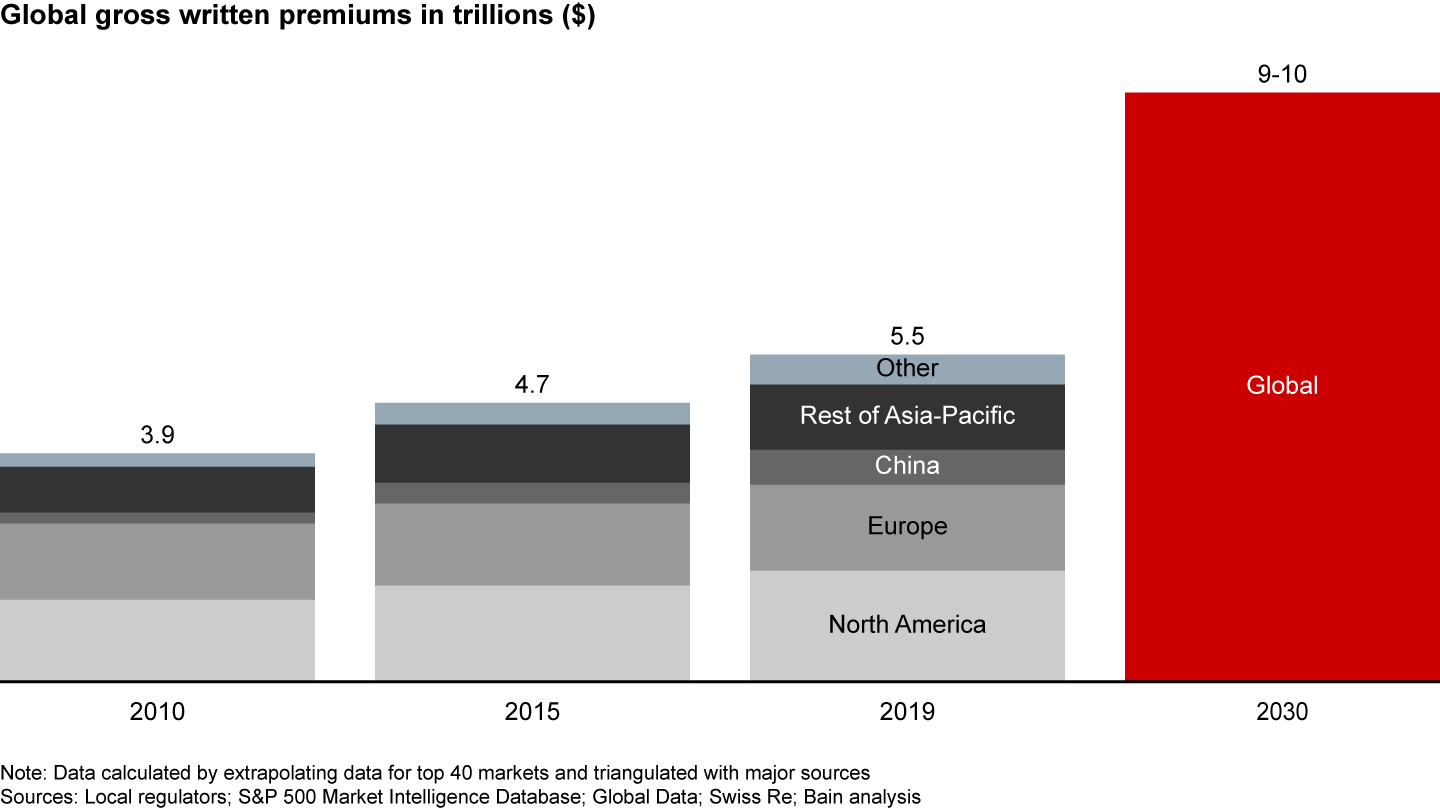

New risk, more risks
Apart from the pandemic, in 2021 alone, a variety of conventional risks (such as flooding in China and Germany and heat waves in the US and Canada) and unconventional risks (ransomware cyberattacks on the Colonial Pipeline) disrupted the lives of millions of people. Such events, once outliers, are becoming the norm.
The profile of risks is changing. They’re declining or flat in mature areas, such as personal auto, workers’ compensation, and mortality; expanding in new areas, such as cybercrime and digital assets; and growing more severe in others, including climate change and infectious disease.
A few numbers illustrate these trends. Mortality and road deaths are dropping, with death rates from motor vehicle accidents in the US per 100 million vehicle miles traveled declining by about 70% over the past four decades (see Figure 2).
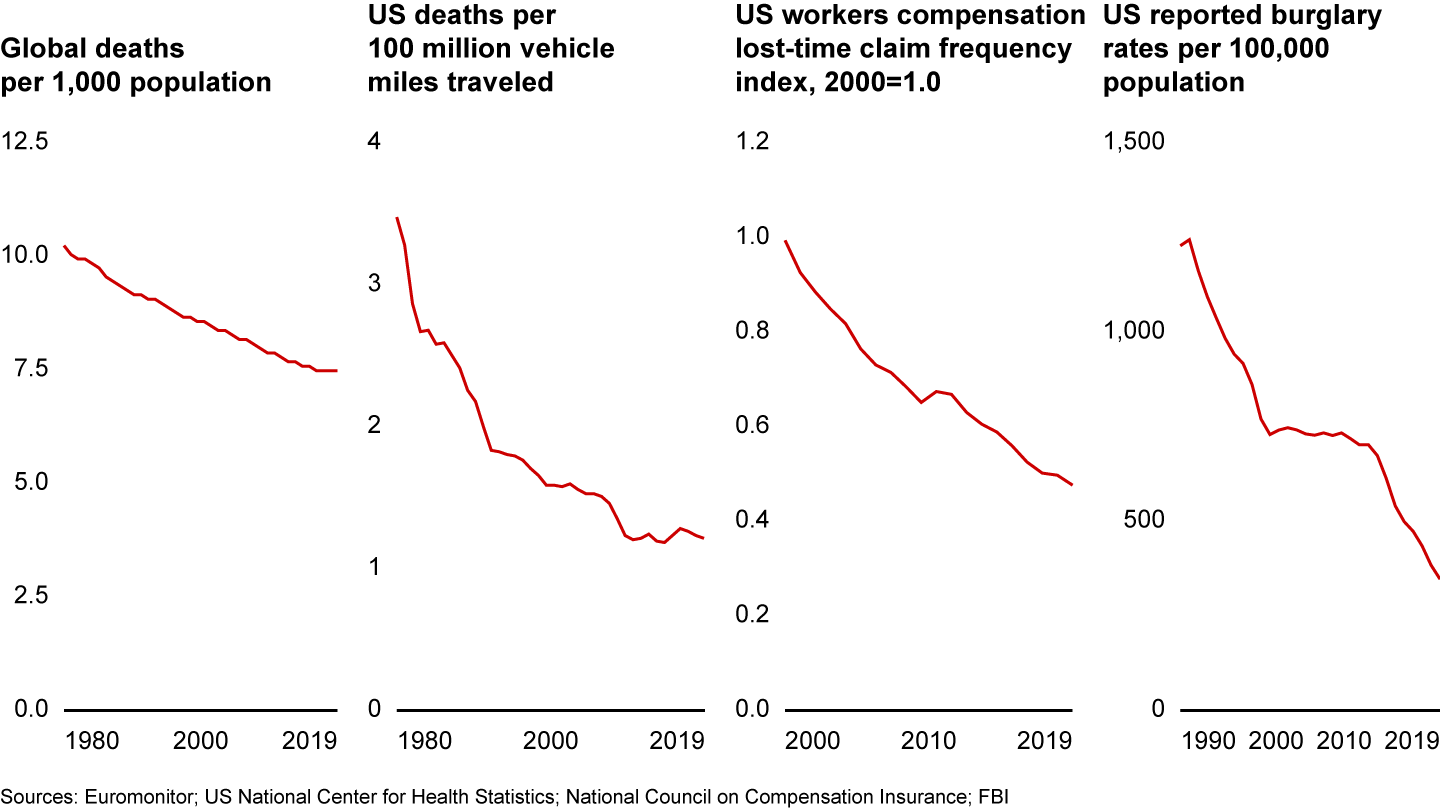

By contrast, we estimate that climate change will result in a roughly tenfold increase in economic losses across natural catastrophes, agricultural output losses, energy demand increases, bio ecosystem damage, water stress, health issues, and the like over the next three decades (see Figure 3). During 2020 alone, Munich Re estimates that the US experienced a record number of wildfires, with losses totaling $16 billion, and a record number of storms during hurricane season, with losses totaling $43 billion.
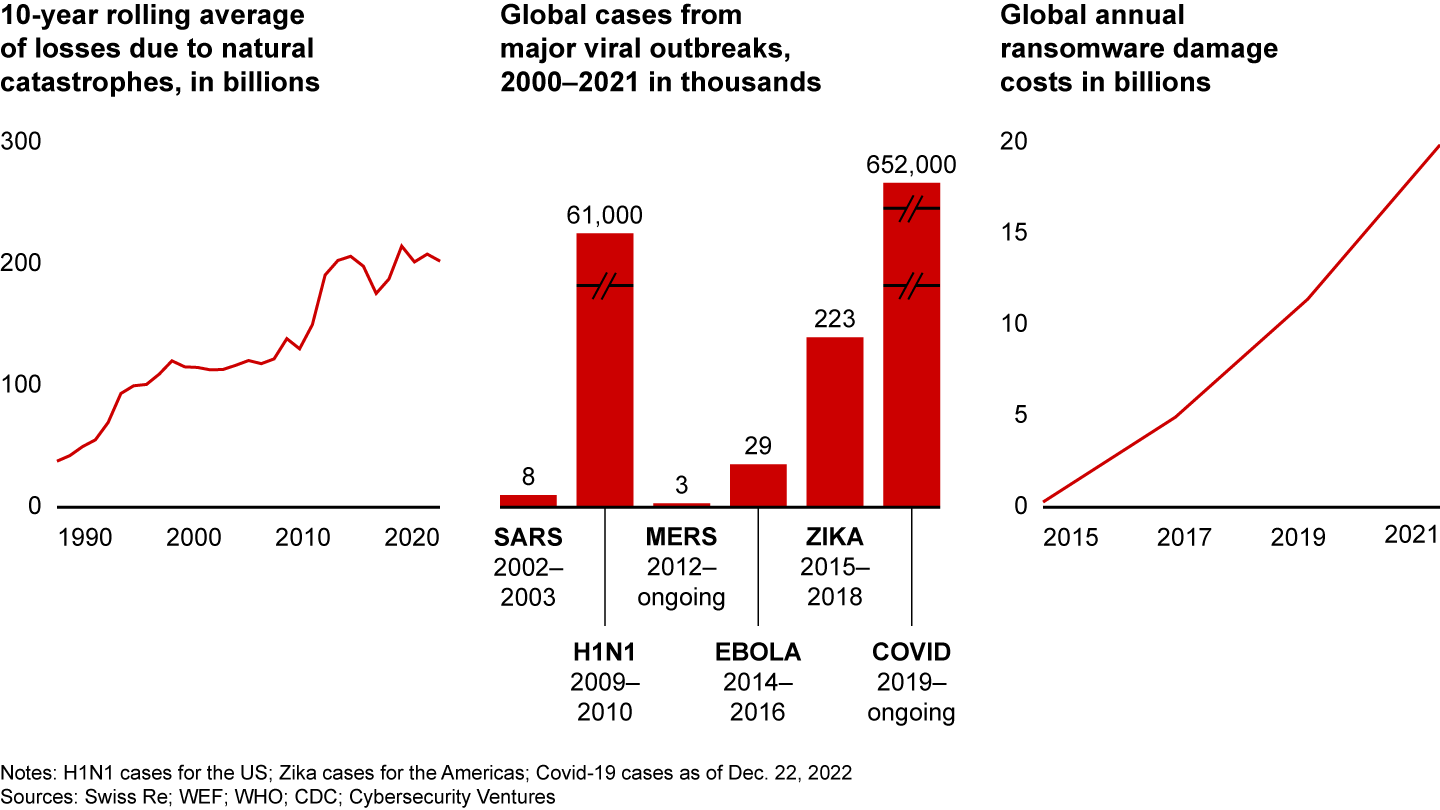

Risk of critical illness is also changing. A study by Brigham and Women’s Hospital found that there has been a dramatic increase in the incidence of early-onset cancers around the world, with most of the incidences among those ages 50 and under. Early life risk exposure results from changes in diet, lifestyle, weight, environmental exposures, and microbiome.
All told, the consequences for an underprotected world may be severe (see Figure 4).
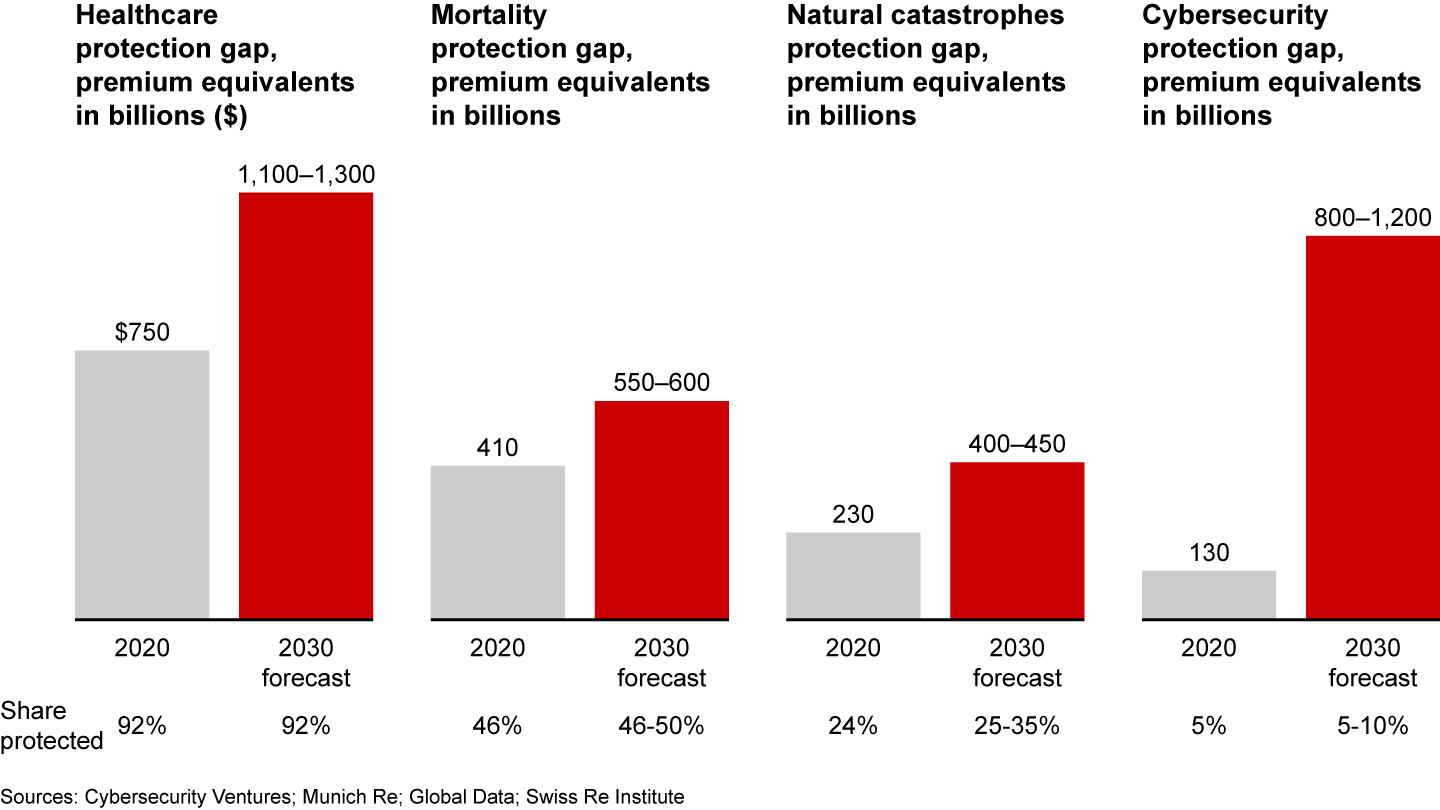

As the risk landscape changes, demand for guarantees and tail-risk protection will likely outstrip supply, meaning products could be expensive and inaccessible for many people. Insurers’ focus might need to shift from savings to complex protection products and, more importantly, risk prevention. New technologies, such as the Internet of Things or machine learning, along with massive data sets, are being deployed to identify, prevent, or mitigate risk events.
“The risk of using AI to do underwriting is reliance on historic data, and if you don’t have technology to retain model and production, if it starts to deteriorate in performance, you incur risks.”
Leading insurers are engaging their customers on health and wellness platforms. For example, Prudential’s PULSE and AIA’s Vitality platform allow health tracking through real-time data fed in from wearable technology. Manulife’s MOVE program and application and Emma by AXA have features such as a rescue line, insurance purchasing, investment monitoring, and financial needs analyzers.
In addition, insurers are starting to build out data-based businesses as new growth engines. An example is Optum, UnitedHealth Group’s information and technology–enabled health services business, which helps people fill a prescription, find specific care, schedule a virtual visit, and manage a health savings account.
What’s driving growth
Risk and protection are shifting toward countries with faster economic growth. The life and health industries in Asia have outpaced other regions; over the past five years, the life insurance industry in Asia-Pacific has recorded the highest growth of 7%, according to Global Data. This growth is expected to continue because of four structural factors (see Figure 5).


The first factor is an aging population. Projections call for 540 million people to be over 65 years old by 2030 in Asia. For this cohort, insurance can be an effective line of defense against chronic disease and other health risks associated with aging. The insurance industry can increase its penetration in this segment by focusing on older consumers’ needs.
The second structural factor is the growth of the middle class. By 2030, projections call for 870 million middle-class people in Asia, defined as households with between 75% and 125% of median income. A recent Insurance Business Asia survey “found that middle-class individuals in emerging markets are more optimistic about their financial well-being, social mobility, and their children’s success than their counterparts in mature markets.” Health, well-being, and financial wealth are also priorities for this growing segment, requiring more risk mitigation and protection services and products.
A third structural factor in Asia consists of the widening protection gap, estimated at $200 trillion by 2030. A higher and wider gap signals that insurance could have better protected those customers.
And the fourth factor involves the widening gap in health insurance being issued. This presents a large opportunity to close this gap in out-of-pocket healthcare spending, projected to increase to $9 trillion by 2030.
Three megatrends to watch
These structural factors pervade the landscape of Asia’s life and health insurance. In addition to these structural factors, three overarching trends are shaping the market in ways that all participants must respond to (see Figure 6). Let’s look at each in turn.
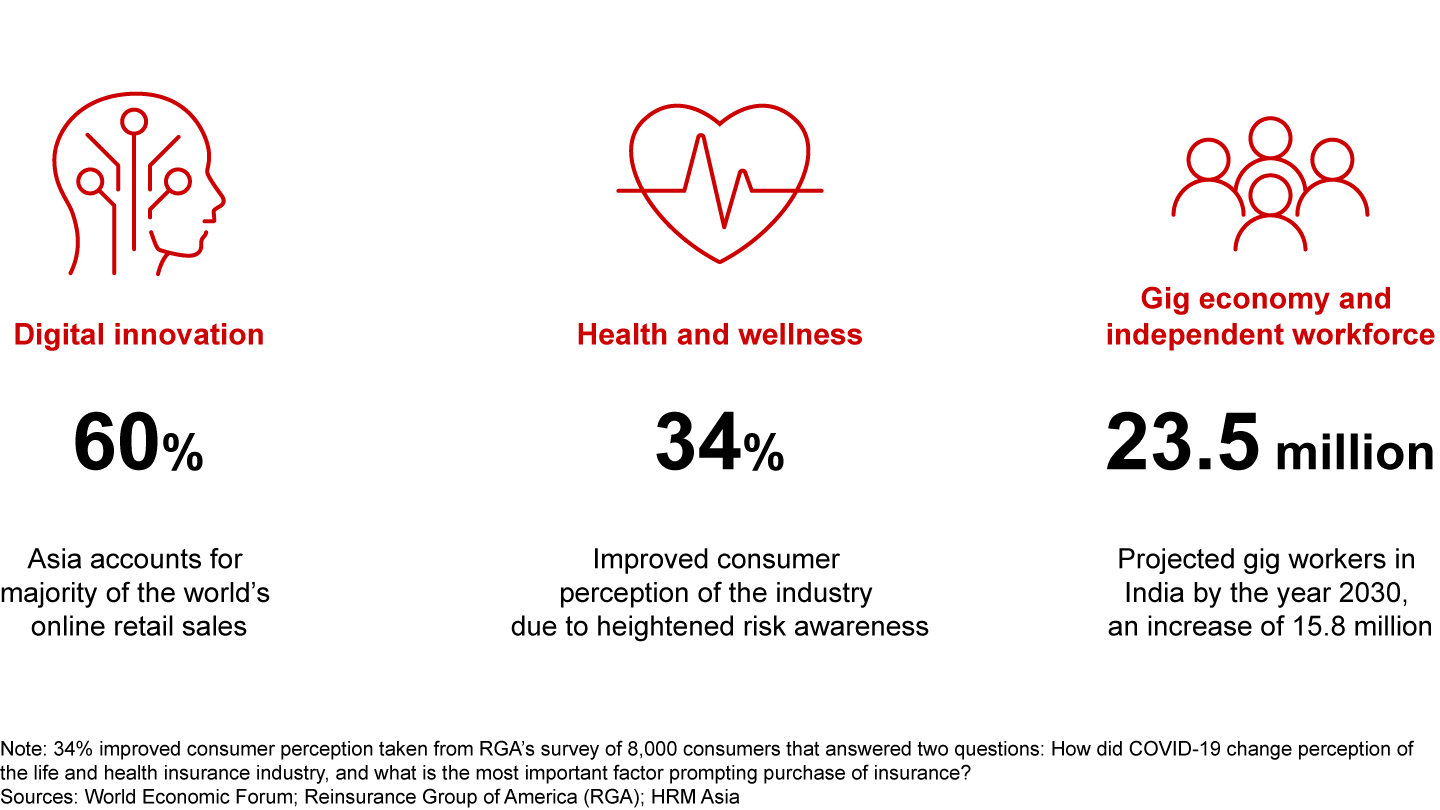

Digital innovation
Digitization is affecting the entire insurance value chain, as new technologies and data use cases enable companies to strengthen their digital capabilities and participate in the platform economy. Propelling this emerging trend are changes in consumers’ online habits and purchasing behavior.
“The timing is right for micro-investment and micro-pension to take off by bundling services with digital in a WhatsApp-like environment that is seamless and frictionless.”
Accelerated by the pandemic, digital purchasing remains a niche channel, but it has become more prominent, with omnichannel being the new normal. In 2021, about 40% of consumers globally surveyed by Bain & Company used a virtual channel, such as Zoom, at least once to interact with agents (see Figure 7). Asian countries such as China, Malaysia, and Singapore have relatively high digital adoption. For example, the Life Insurance Association Singapore reported a sixfold increase in sales of insurance products through direct channels from 2020 to 2021. Other developing countries in Asia may follow in terms of digital channel adoption.


Demand for digitalization has driven large numbers of insurtech companies into the market. A survey by Salesforce found that customers are looking for insurtech firms to offer seamless experiences, self-service options, and personalized experiences.
“Regulations are relatively relaxed now as there have not been many adverse outcomes with the use of AI, but regulators are constantly trying to understand the AI and machine learning model.”
There are at least 335 insurtechs in Asia, mostly in India, China, and Southeast Asia. According to S&P Global Market Intelligence, insurtech start-ups have attracted 78% of investments in the sector.
Based on these developments, we have started to also see regulatory shifts across insurance lines and regions. For example, when the pandemic hit in 2020, regulators in Malaysia and Indonesia launched regulation to support and govern the sales of insurance through online channels. The regulation aims to promote customer convenience, protection, and data privacy. We believe Asian regulators will continue to play an active role in ensuring sustainable growth, making digital journeys and transactions safe for consumers.
Heightened awareness of health-related risks
Covid-19 underscored the vital role of insurance in strengthening household resilience. Consumers have grown more aware of the risks of critical illness, loss of a breadwinner, and retirement instability. This awareness has spurred more demand for life and health protection policies. It’s one reason Bain estimates that policies in developing Asian countries will outpace the global life insurance market (see Figure 8).
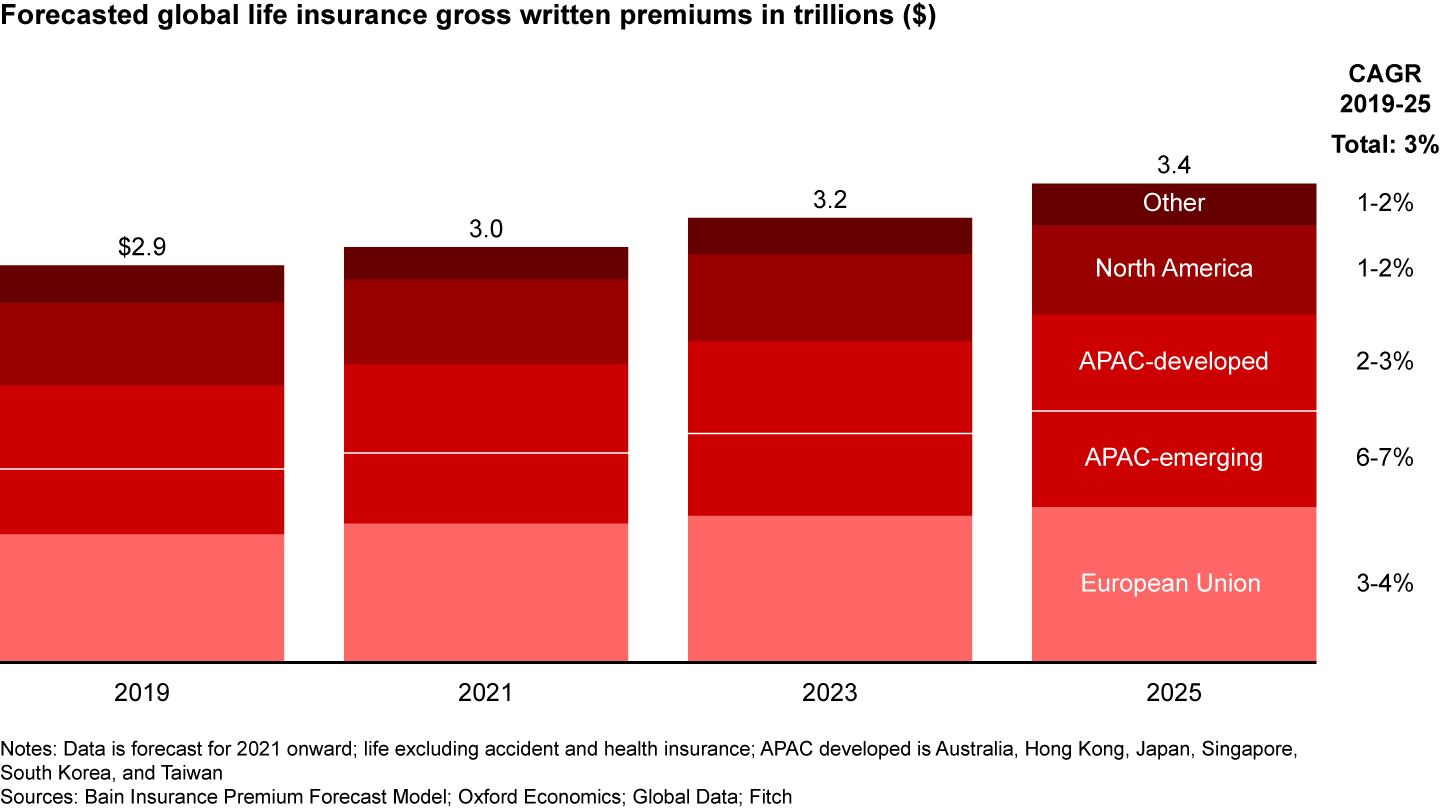

According to Swiss Re Institute, eight in ten households across the Asia markets report being not fully confident of their ability to handle the financial hit resulting from the death of a main breadwinner. However, customers still do not think of life insurance as a top-of-mind solution for achieving financial security; preferred routes still focus on earning more and buying more medical or accident insurance.
This presents huge opportunities for life insurers, but they need to educate consumers about the benefits of life protection with clear communication and easily understood products. Swiss Re Institute estimates that closing the mortality protection gap could result in an additional annual premium of $292 billion per year.
As consumers increasingly perceive health protection as essential, the path to unlocking growth seems easier for health insurers. Coupled with other structural drivers such as longer life expectancy, healthcare spending in Asia is estimated to exceed $4 trillion by 2024, according to Quadria Capital.
The rise of the gig economy and remote workers
Remote and gig economy work changes the landscape of employee benefits, retirement coverage, and income protection. According to pinBox Solutions, over 1.8 billion self-employed workers constitute between 70% and 95% of the total workforce across developing countries (see Figure 9). Of these, over 1.2 billion cannot save money due to supply-side barriers and demand-side constraints, as long-term contributions to pension funds decline with the shift from traditional jobs to freelancing.


“Micro-finance development is an example of the potential in the savings space for informal workers.”
The reasons to start saving and contributing to pensions for marginal and vulnerable sections of society are quite compelling, and micro-pension products are expected to address this challenge. According to Innovations for Poverty Action’s survey, 80% of respondents in India reported interest in micro-pensions, and many value features that would restrict early withdrawals. Some companies are trying to capture a share of this growing market. For example, WhatsApp announced an initiative to partner with HDFC Pension, an Indian investment management firm, to take the National Pension Scheme products onto its platform in India.
Imperatives for insurers
Insurers looking to capture the major opportunity that the Asian life and health market offers will need to excel along several imperative dimensions.
Reinvent the propositions from risk protection to risk prevention
A strong customer-led mindset is crucial to capturing a customer’s share of wallet and loyalty. Insurers should start reimagining how they can address customers’ priorities by extending their offerings to include other value-added services.
Customers want insurers to not only provide risk protection but to also help mitigate and prevent risks. A Bain survey in 2022 found that many customers were interested in risk prevention in their daily lives (see Figure 10). This presents an opening for insurers to redefine what value they add to customers, manage losses and expenses, and generate additional profits.
Some insurers have begun to work with customers and governments to prevent risks via behavioral change, advanced risk identification, tracking, and management. Leading life and health insurers are starting to reward customers through features such as premium discounts and free health checks for participating in risk prevention services, such as subscribing to health data trackers.
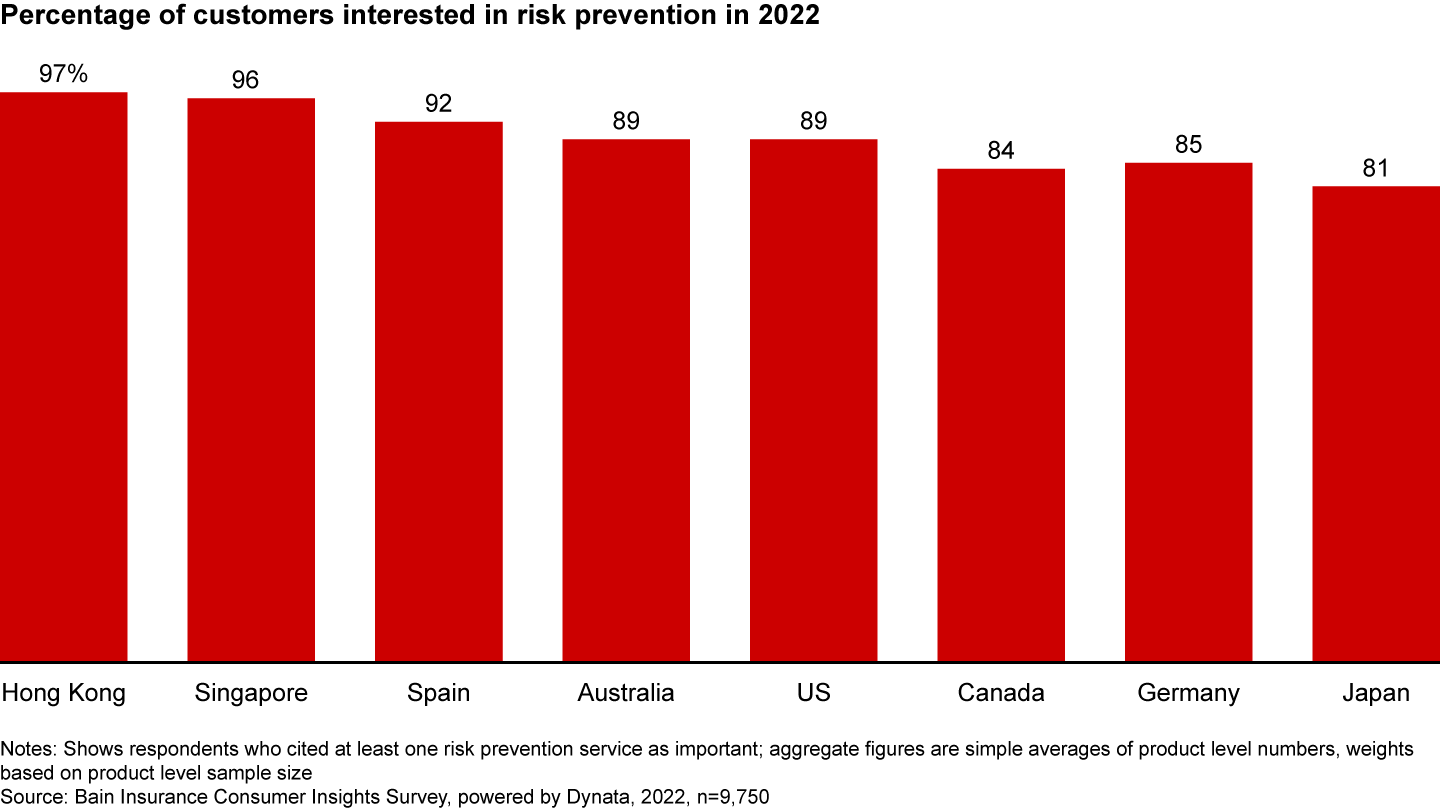

Embrace a seamless omnichannel model for a better customer experience
While many incumbent insurers perform adequately on functional elements such as the quality of products and reducing risk, they often fail to make interactions simple, even though their customers consider ease of use very important.
“Insurance is behind compared to other verticals in financial services, from the customer experience standpoint, especially the onboarding journey. The experiences in onboarding customers are still quite time-consuming and invasive.”
Customer experiences play a pivotal role in winning customers’ business and advocacy. Insurers need to deliver holistic customer experiences that are simple, convenient, and hassle free while still allowing for personalization or modular purchase. A Bain survey in 2020 found that customers who did not encounter problems in their digital transactions tended to give their insurer a higher loyalty score.
“We discovered that some customers do not want to go purely digital anymore; they want to go offline. So we need to have an omnichannel experience to keep the entire online and offline journey circular while capturing data on what is important for our customers.”
Purely in-person interactions with agents and other employees are becoming less prominent as customers increasingly research and shop for insurance through digital channels. However, customers continue to expect cross-channel engagement and human-assisted advisory, so agents will continue to play a critical role in distribution. Effective ways of working will change dramatically as agents spend less time on low-value tasks and more time on relationship-building and high-quality advice. Distribution channels may evolve in three ways.
- The agency channel will evolve to meet customers’ needs. Insurers will need to invest in three dimensions of an agency model:
- Enabling a seamless transition from online to offline experiences. The channel should not only be digitized but should also allow the interlinkage of channels, enabling a holistic view of customer experiences along essential touchpoints. A customer’s interactions across touchpoints should be leveraged to collect data, foster engagement, and convert to sales occasions.
- Developing a true advisory model to unlock the value of agents. While customers have embraced digital search and shopping, they still want to speak with an agent for more complex issues. As a result, agents will increasingly focus on providing high-quality advice around the broader proposition, which includes an ecosystem of services provided by partners. Companies will need to equip agents with the right training, tools, metrics, coaching, and incentives to excel in remote advisory.
- Introduce digital tools to the sales journey. For example, remote collaboration could be more seamless with the use of co-browsing features, allowing agents to share materials with clients. A lead generation engine could substantially raise agent productivity. Digital underwriting engines for straight-through processing, and instant policy issuance at the point of sales, could drive efficiencies in back-end processes.
“We are harnessing the power of digital and technology to enable our agents to better serve their customers as they do their work, day in and day out.”
- Proprietary bank channel will remain a source of competitive advantage. To capture more value, insurers will need to work with banks to leverage data, technology, and new ways of working. We see two prominent shifts in how bancassurance channel could evolve:
- From “conversation at branches” to “omnichannel experiences.” As fewer customers visit physical bank branches, not being able to continue with the application on other devices will significantly limit the chance of sales conversion. When bancassurance companies set about integrating channels and platforms, they should ensure that any device can complete the journey.
- From “channel providers” to “holistic financial advisors.” Banks and insurers need to work together in using data and AI to promote insurance conversion among savers, via personalized advice. For example, some leading companies have used AI to develop a “someone-like-you” feature, providing personalized insight and financial planning, and introducing the insurance solution that best fits a customer profile. Data also figures in developing a “true risk score” to enhance underwriting capability, saving cost and time in the approval process.
-
Use embedded insurance in certain product lines to reshape the distribution channel and to improve customer acquisition and conversion. Customers increasingly trust digital platforms as a provider of insurance. Bain estimates that embedded insurance will play a significant role in distribution, representing up to 25% of gross written premiums in property and casualty by 2030.
Embedded insurance bundles coverage or protection within the purchase of a product or a service itself, offered in real time or at the point of sale, offers unconventional ways to forge relationships with new customers who may not have engaged with traditional insurance products. For example, in Southeast Asia, Grab has partnered with Chubb to offer travel, accident, hospitalization, and other insurance embedded in the core ride-hailing product.
“The journey should be part of consumer's lifestyle, so provision of insurance is invisible, but consumers get to be covered in life, health, and insurance.”
Address the growing pool of wealthy customers in Asia
Wealth management is one of the fastest-growing businesses globally, and Asia is no exception. The region’s wealth-services customers are projected to continue to grow, driven by the growth of ultra-high-net-worth and high-net-worth segments, which are projected to reach about 10 million individuals, generating liquid assets under management of more than $6 trillion (see Figure 11).
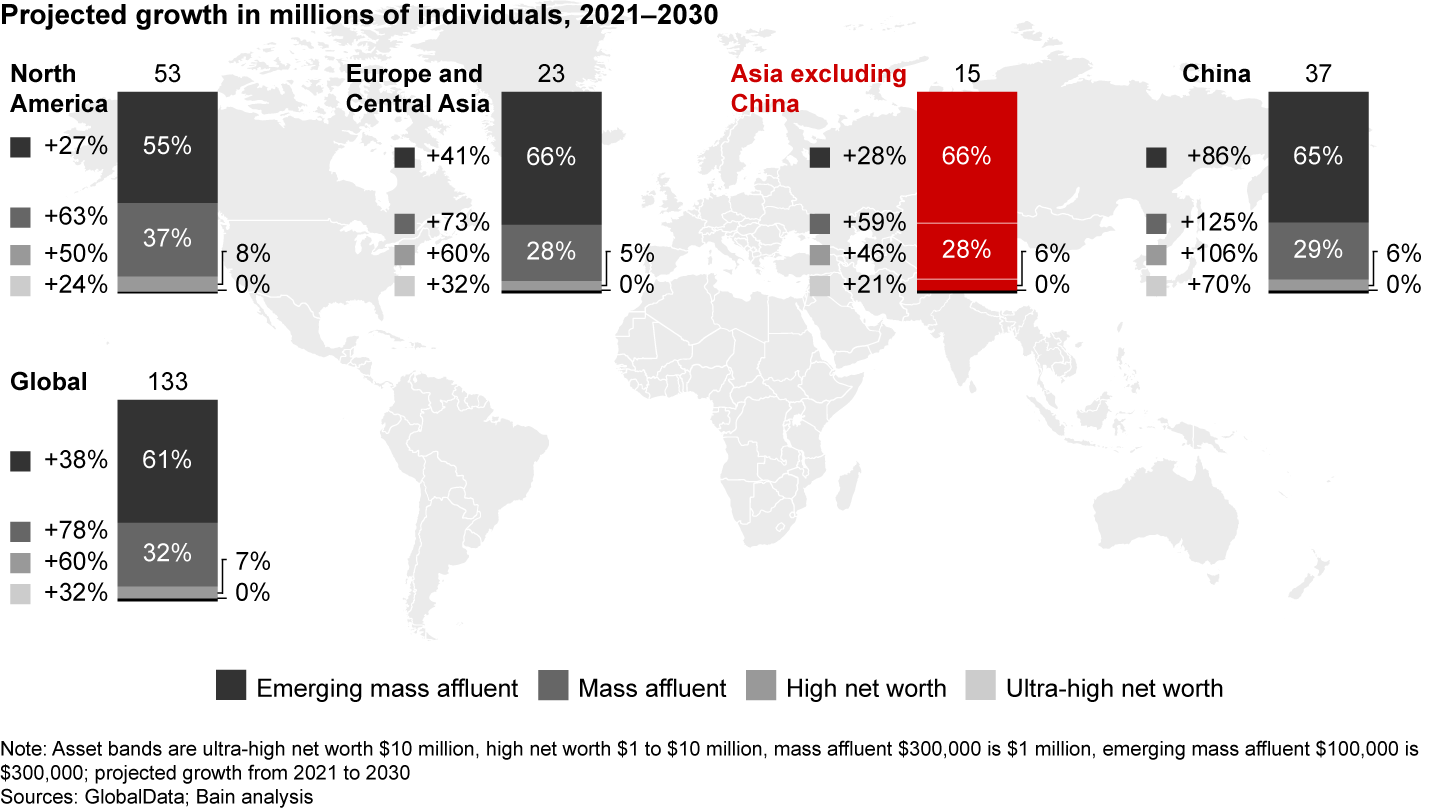

These segments represent major opportunities for insurers, given the capital efficiency and potential for recurring revenue streams. Success here will require a deliberate and focused approach. The demographic shifts will require insurers to embrace a different strategy and adapt their delivery model and proposition, based on the evolving needs and priorities of customers.
For example, Generation Y and Z customers care about sustainability, are more self-directed and fluent with digital tools, yet still appreciate human interaction for difficult decisions. For this segment, insurers should start introducing highly digital self-service but still include human interaction for advice. The advisor role thus changes from a full-service advisor to an advisor for a complex or tricky situation, and the role of a wealth management firm becomes more active in establishing and maintaining customer relationships. For baby boomers, on the other hand, insurers need to respond to retirement needs with decumulation-focused products.
Invest in next-generation technology and data
Technology will be central to insurance in the future, notably to improve customer experiences and reduce cost.
As customers expect a truly integrated and seamless digital experience, insurers will need to strengthen capabilities in digital platforms, AI, and data analytics.
Some insurers have a head start in developing their own digital platform to engage customers. For example, since Prudential launched its Pulse health ecosystem platform, it has attracted over one million new customers, issued over 1.8 million policies, and serves as a virtual agency tool in the Philippines and Malaysia. Pulse allows users to access and purchase bite-sized products, connect to agents, and administer their policy online. The platform also offers other health and wellness features, such as connecting the user’s health information to wearable devices and offering an AI-powered symptom checker.
“Data today allow us to create new products and segment our customers better.”
AI and advanced data analytics will help insurers better understand customer behavior and personalize the customer experience. Through AI-based, tailored campaigns and offerings, insurers can improve conversion rates by offering customers and prospects the products they are most likely to accept. AI can also complement human customer service, offering round-the-clock support using intelligent, cognitive agents and chatbots.
Besides improving the customer experience, technology will allow insurers to provide protection at much lower costs in three ways: matching price to risk, improving risk prevention and mitigation, and spurring efficiency gains. Let’s look at each in turn.
- Matching price to risk. The proliferation of data will allow insurers to improve risk profiling and pricing, reduce fraud, and reduce underwriting loss through risk prevention. For example, Ping An has begun to use data and predictive analytics to assess the health conditions of customers. Allianz analyzes driving behavior data so that auto insurance customers can obtain up to a 30% discount on their policies depending on their driving behavior and safety.
"Responsible AI is used to make sure that insurers don’t go bankrupt by paying claims they haven’t priced for and to make sure that customers get insurance at an affordable risk-adequate rate.”
- Improving risk prevention and mitigation. Velvetech estimates that insurance fraud in the US leads to about $80 billion in losses every year. With the rise in the use of predictive analytics for fraud detection and natural language processing for analyzing historical data of fraudulent claims, insurers will be able to save time and money. Anadolu Sigorta, a Turkish insurer, has tested a predictive fraud detection system to replace the process of manually reviewing every submitted claim for signs of fraud—leading to $5.7 million savings in fraud detection and prevention costs in just one year.
- Driving efficiency gains. Insurance traditionally has relied on tedious, manual processes that involve multiple forms, extensive data gathering, and heavy information processing. Further digitization of back-office operations will help to optimize these administrative tasks for better accuracy and faster speed. Robotic process automation (RPA) can serve in business underwriting to access information from several sources, in claims processing to accelerate the process by extracting information, and in business analytics to generate end-to-end information for audits and reviews.
For example, Dai-ichi Life Insurance uses RPA to improve speed up for routine tasks, resulting in 132,000 hours saved since 2017 across 39 departments. Progressive is starting to use predictive analytics to improve policy administration and to optimize call routing for customer service agents.
“Reducing transaction cost is important in dealing with people with micro-saving capabilities. AI can be used to train bots in an environment where it can provide ongoing and constant handholding, making servicing these people much more automated.”
Over 500 fintech firms, financial institutions, technology firms, and policymakers participated in the Singapore Fintech Festival 2022. Elevandi is the key organization to make SFF 2022 possible.
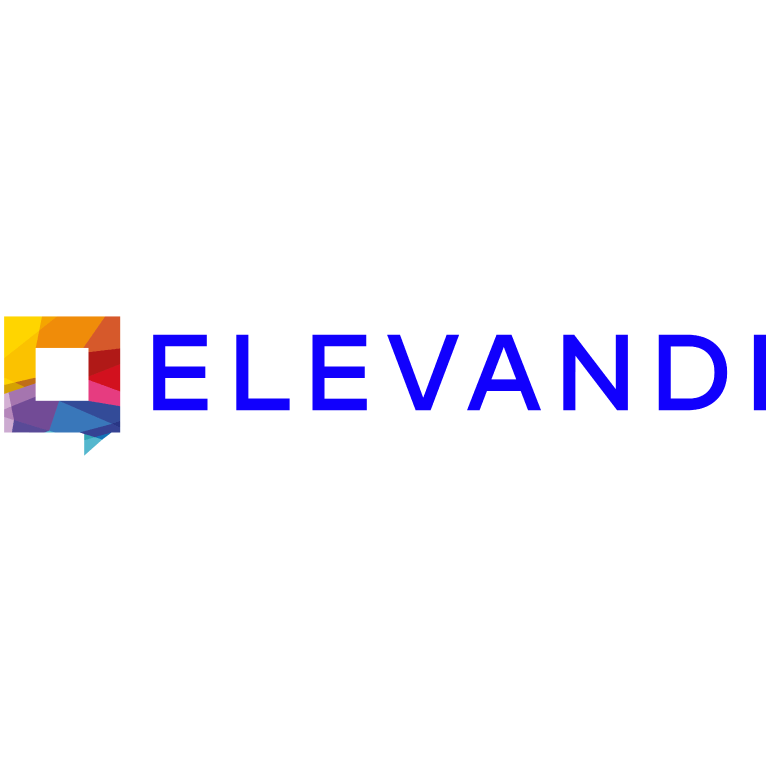
About Elevandi
Elevandi is set up by the Monetary Authority of Singapore (MAS) to foster an open dialogue between the public and private sectors to advance FinTech in the digital economy. Elevandi works closely with governments, founders, investors, and corporate leaders to drive collaboration, education, and new sources of value at the industry and national levels. Elevandi’s initiatives have convened over 350,000 people since 2016 to drive the growth of FinTech through events, closed-door roundtables, investor programs, educational initiatives, and research. Besides the Singapore FinTech Festival, Elevandi organizes other forums, including the World FinTech Festival and Point Zero Forum.